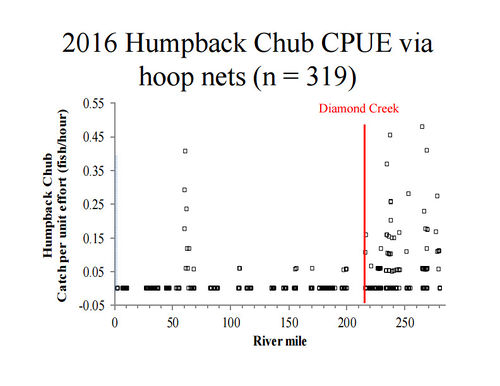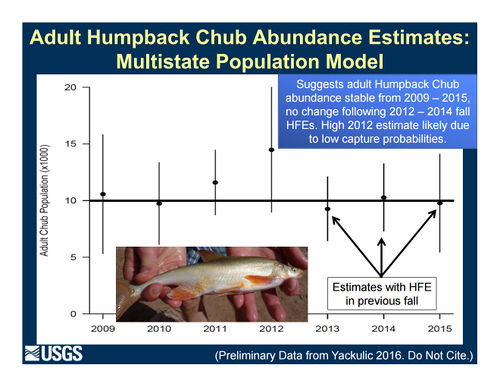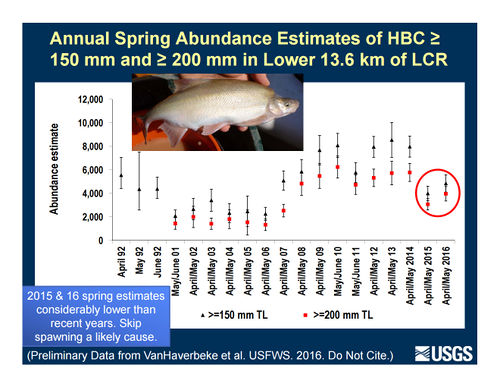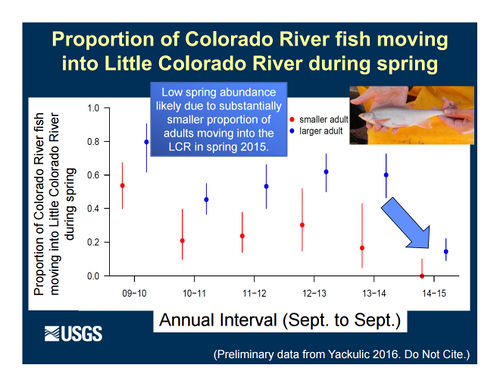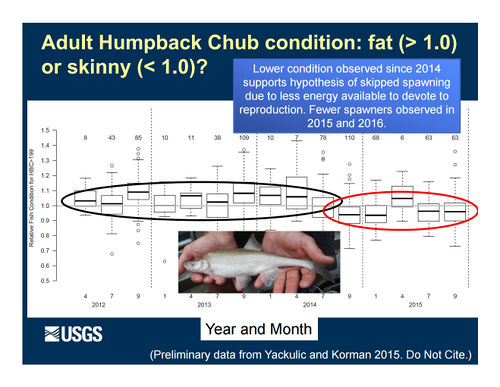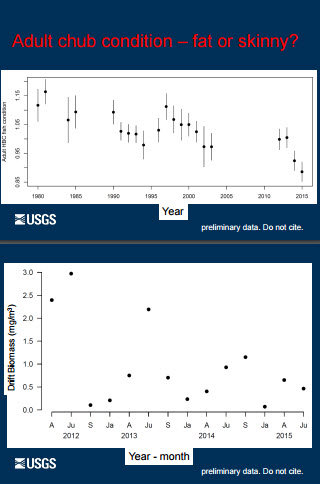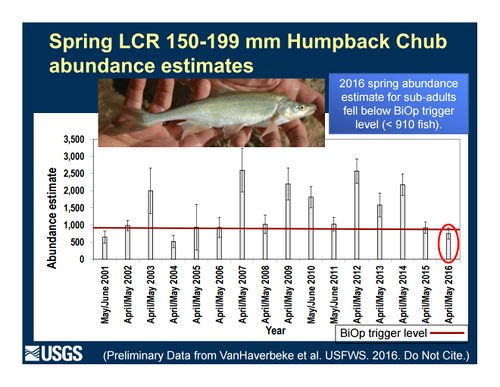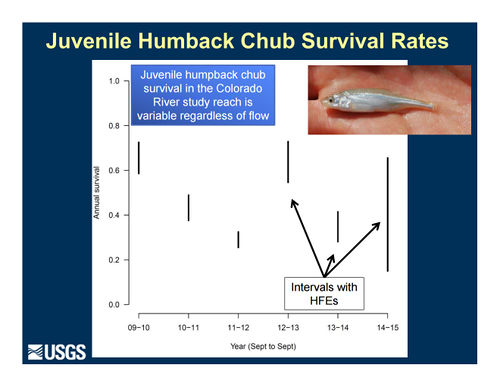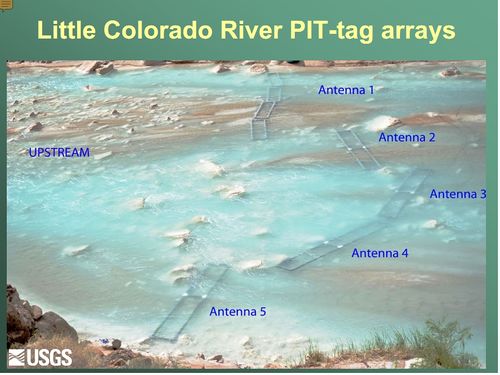|
|
| Line 65: |
Line 65: |
| | |- | | |- |
| | |style="color:#000;"| | | |style="color:#000;"| |
| | + | |
| | + | [[File:HBCsummary2016.jpg|center|500px]] [https://www.usbr.gov/uc/rm/amp/twg/mtgs/17jan26/AR8_Yackulic.pdf] |
| | | | |
| | [[File:HBC_WGChoopnets.jpg|center|500px]] | | [[File:HBC_WGChoopnets.jpg|center|500px]] |
| Line 90: |
Line 92: |
| | [[File:HBCpopEst ASMR2011.jpg|center|500px]] | | [[File:HBCpopEst ASMR2011.jpg|center|500px]] |
| | ASMR estimates for humpback chub numbers at the LCR | | ASMR estimates for humpback chub numbers at the LCR |
| − |
| |
| − | [[File:Important Science Insight of 2012 page 1.jpg|center|500px]]
| |
| | | | |
| | | | |
| Line 162: |
Line 162: |
| | '''2017''' | | '''2017''' |
| | *[https://www.usbr.gov/uc/rm/amp/twg/mtgs/17jan26/AR20_Rogowski.pdf System Wide Monitoring PPT] | | *[https://www.usbr.gov/uc/rm/amp/twg/mtgs/17jan26/AR20_Rogowski.pdf System Wide Monitoring PPT] |
| − | *[https://doi.org/10.3133/ofr20161177 Persons, W.R., Van Haverbeke, D.R., and Dodrill, M.J., 2017, Colorado River fish monitoring in Grand Canyon, Arizona; 2002–14 humpback chub aggregations: U.S. Geological Survey Open-File Report 2016–1177, 43 p.]
| |
| | *[https://www.usbr.gov/uc/rm/amp/twg/mtgs/17jan26/AR8_Yackulic Humpback Chub that Spawn in the LCR: Status and Drivers PPT] | | *[https://www.usbr.gov/uc/rm/amp/twg/mtgs/17jan26/AR8_Yackulic Humpback Chub that Spawn in the LCR: Status and Drivers PPT] |
| | *[https://www.usbr.gov/uc/rm/amp/twg/mtgs/17jan26/AR9_VanHaverbeck.pdf Humpback Chub in the Little Colorado River, Monitoring of Juveniles, Sub-Adults, and Adults and translocations PPT] | | *[https://www.usbr.gov/uc/rm/amp/twg/mtgs/17jan26/AR9_VanHaverbeck.pdf Humpback Chub in the Little Colorado River, Monitoring of Juveniles, Sub-Adults, and Adults and translocations PPT] |
| | *[https://www.usbr.gov/uc/rm/amp/twg/mtgs/17jan26/AR12_Young.pdf Humpback Chub Aggregations Updated (6.1)] | | *[https://www.usbr.gov/uc/rm/amp/twg/mtgs/17jan26/AR12_Young.pdf Humpback Chub Aggregations Updated (6.1)] |
| | *[https://www.usbr.gov/uc/rm/amp/twg/mtgs/17jan26/AR13_VanHaverbeke.pdf Humpback Chub in the Little Colorado River and Translocations PPT] | | *[https://www.usbr.gov/uc/rm/amp/twg/mtgs/17jan26/AR13_VanHaverbeke.pdf Humpback Chub in the Little Colorado River and Translocations PPT] |
| | + | *[https://doi.org/10.3133/ofr20161177 Persons, W.R., Van Haverbeke, D.R., and Dodrill, M.J., 2017, Colorado River fish monitoring in Grand Canyon, Arizona; 2002–14 humpback chub aggregations: U.S. Geological Survey Open-File Report 2016–1177, 43 p.] |
| | | | |
| | '''2016''' | | '''2016''' |
|
File:Humpback-large- PIC.jpg*
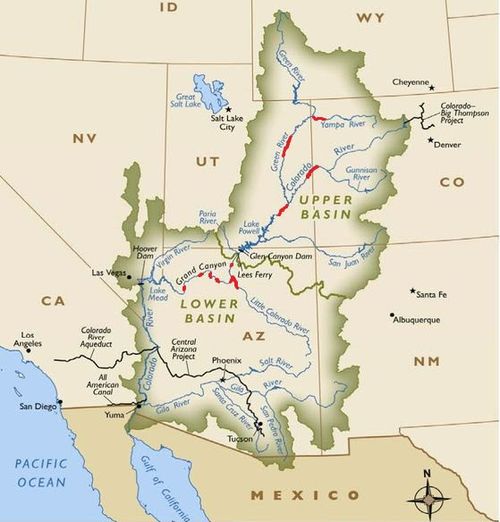
|
Description
The humpback chub (Gila cypha) is an endangered, native endemic of the Colorado River that evolved around 3-5 million years ago. The pronounced hump behind its head gives this fish a striking, unusual appearance. It has an olive-colored back, silver sides, a white belly, small eyes and a long snout that overhangs its jaw. Like the Colorado pikeminnow and bonytail, the humpback chub is a member of the minnow family.
The humpback chub is a relatively small fish by most standards – its maximum size is about 20 inches and 2.5 pounds. By minnow standards it is a big fish, though not like the giant of all minnows – the Colorado pikeminnow. Humpback chub can survive more than 30 years in the wild. It can spawn as young as 2 to 3 years of age during its March through July spawning season.
Although the humpback chub does not have the swimming speed or strength of the Colorado pikeminnow, its body is uniquely formed to help it survive in its whitewater habitat. The hump that gives this fish its name acts as a stabilizer and a hydrodynamic foil that helps it maintain position and also probably helped it escape predation by making it difficult to be swallowed by all but the largest pikeminnow. The humpback chub uses its large fins to “glide” in eddy complexes, feeding on insects that become trapped in pockets of slow-moving water. [1]
Status and distribution
The humpback chub was listed as endangered by U.S. Fish and Wildlife Service in 1967 and given full protection under the Endangered Species Act of 1973. Historically, humpback chub were probably limited to the eddy complexes of several canyon reaches of the Colorado River and three of its tributaries: the Green and Yampa rivers in Colorado and Utah, and the Little Colorado River in Arizona. The species was first described in 1946. Before that time, few people ventured into these treacherous canyons – including fishery biologists.
Today, five self-sustaining populations of humpback chub occur in the Upper Colorado River Basin. Two to three thousand adults can occur in the Black Rocks and Westwater Canyon core population in the Colorado River near the Colorado/Utah border. Several hundred to more than 1,000 adults may occur in the Desolation/Gray Canyon core population in the Green River. Populations in Yampa and Cataract canyons are small, each consisting of up to a few hundred adults. The largest population of humpback chub is found in the Grand Canyon -- primarily in the Little Colorado River (LCR) and its confluence with the main stem Colorado River. In 2009, the U.S. Geological Survey announced that this population increased by about 50 percent from 2001 to 2008 to between 6,000 and 10,000 adults.
One of the primary threats to humpback chub has been the proliferation of warm-water nonnative fish predators like smallmouth bass and northern pike. [2]
• Achieve HBC recovery in accord with the Endangered Species Act (ESA), the HBC comprehensive management plan, and with the assistance of collaborators within and external to the AMP.
• A self-sustaining HBC population in its natural range in the CRE.
• An ecologically appropriate habitat for the HBC in the mainstem.
• Spawning habitat for HBC in the Lower Little Colorado.
• Establish additional HBC spawning habitat and spawning aggregations within the CRE, where feasible.
• Adequate survival of young-of-year or juvenile HBC that enter the mainstem to maintain reproductive potential of the population and achieve population sizes consistent with recovery goals.
|
Updates
|
|
[3]
Catches of humpback chub during 2016 system-wide monitoring [4]
The multistate population estimate for the Little Colorado River humpback chub aggregation.
Estimates of humpback chub coming into the LCR to spawn. The decline in 2015 and 2016 coincides with a decline in chub condition and a decline in the trout population (remember trout and chub eat the same things and are considered competitors). This may be an indication of skip-spawning in 2015 and remaining in the mainstem, not an actual decline in population.
Estimate of the proportion of mainstem humpback chub moving into Little Colorado River during the spring spawning season.
Body condition of humpback chub has been declining with the decline in macroinvertebrates in the drift. Note that most of the drift occurs in the summer when macroinvertebrate production is high. This decline in macroinvertebrate production coincides with the population expansion and subsequent decline in the rainbow trout population indicating competition between rainbow trout and humpback chub.
Spring LCR 150-199 mm Humpback Chub abundance estimates
Juvenile Humback Chub Survival Rates
ASMR estimates for humpback chub numbers at the LCR
|
|
Links and Information
|
|
|
Humpback Chub Documents
|
|
|
2011 BiOp Conservation Measures for Humpback Chub
|
|
Conservation measures identified in the 2011 BO on Operations of Glen Canyon Dam include:
- the establishment of a humpback chub refuge;
- evaluation of the suitability of habitat in the lower Grand Canyon for the razorback sucker (Xyrauchen texanus);
- establishment of an augmentation program for the razorback sucker, if appropriate;
- humpback chub translocation;
- Bright Angel Creek brown trout control;
- Kanab ambersnail (Oxyloma haydeni kanabensis) monitoring;
- determination of the feasibility of flow options to control trout, including increasing daily down-ramp rates to strand or displace age-0 trout, and high flow followed by low flow to strand or displace age-0 trout;
- assessments of the effects of actions on humpback chub populations;
- sediment research to determine effects of equalization flows; and
- Asian tapeworm (Bothriocephalus acheilognathi) monitoring.
|
LTEMP BiOp Triggers for Humpback Chub (2016)
|
|
If the Tier 1 (point abundance estimate for adult chub in the Colorado River mainstem aggregation and Little Colorado River fall below 9,000 as estimated by the currently accepted population model OR if recruitment of sub-adult chub [150-199 mm] does not equal or exceed estimated adult mortality as described in document) and Tier 2 triggers (point abundance estimate of adult chub decline to <7,000 fish, as estimated by the currently accepted humpback chub population model) are met and the prescribed conservation measures and remedial actions under each trigger do not mitigate a decline in the humpback chub population, then incidental take will have been exceeded.
Tier 1 would emphasize conservation actions (i.e., expansion of translocation actions in the Little Colorado River, head-starting larval chub to later translocate) that would take place early during an adult or sub-adult humpback chub population decline (should that happen). Tier 2 would serve as a backstop prescribing mechanical nonnative predator removal (threat reduction) if conservation measures did not mitigate a decline in chub abundance.
|
Presentations and Papers
|
|
2017
- System Wide Monitoring PPT
- Humpback Chub that Spawn in the LCR: Status and Drivers PPT
- Humpback Chub in the Little Colorado River, Monitoring of Juveniles, Sub-Adults, and Adults and translocations PPT
- Humpback Chub Aggregations Updated (6.1)
- Humpback Chub in the Little Colorado River and Translocations PPT
- Persons, W.R., Van Haverbeke, D.R., and Dodrill, M.J., 2017, Colorado River fish monitoring in Grand Canyon, Arizona; 2002–14 humpback chub aggregations: U.S. Geological Survey Open-File Report 2016–1177, 43 p.
2016
- Recovery: Humpback Chubs, New Values and New Hope for Endangered Native Fish
- Grand Canyon Monitoring and Research Center Science Updates (BO Compliance, Trout Updates, Green Sunfish, Fisheries PEP, Partners in Science)
- Spring 2016 Chute Falls humpback chub sampling trip report
- Spring 2016 Lower LCR humpback chub sampling trip report
- Mark-Recapture and Fish Monitoring Activities in the Little Colorado River in Grand Canyon Colorado River in Grand Canyon from 2000 to 2015
- Effects of Turbidity on Predation Vulnerability of Juvenile Humpback Chub to Rainbow and Brown Trout
- Recovery Plan update for Humpback Chub
- Humpback chub in the Little Colorado River, Monitoring of Juveniles, Sub-Adults, and Adults and Translocations
- Humpback Chub Translocations to Havasu and Shinumo Creeks, Grand Canyon National Park
- Humpback chub (Gila cypha) that Spawn in the Little Colorado River: Status and Potential Drivers
- Factors that Influence Juvenile Humpback Chub Survival
- Use of Ultrasonic Imaging to Evaluate Egg Maturation of Humpback Chub (Gila cypha) in Grand Canyon
- Monitoring Humpback Chub Aggregations in the Mainstem, 1991-2015
2015
- Finch, C., W.E. Pine III, C.B. Yackulic, M.J. Dodrill, M. Yard, B.S. Gerig, L.G. Coggins, Jr., and J. Korman, 2015, “Assessing Juvenile Native Fish Demographic Responses to a Steady Flow Experiment in a Large Regulated River,” River Research and Applications. doi:10.1002/rra.2893.
- Havasu Creek Translocation Update
- Native-nonnative Interactions; Factors Influencing Predation and Competition
- Humpback chub triggers for nonnative fish control in the 2011 Biological Opinion (2015 status update)
- Humpback chub triggers for nonnative fish control in the 2011 Biological Opinion
- Chute Falls Translocation Update
- Humpback Chub Translocations to Shinumo and Havasu Creeks, Grand Canyon National Park
- Humpback Chub in the Colorado river: Status and Trends of Aggregations, Changes in Range
- Early Life History of Humpback Chub: Patterns and Potential Drivers
- Biological Opinion Trigger Update: January 2015
2014
2013
- GCMRC Update - Status of Resources and Sediment Conditions
- GCMRC Science Update on Sediment and Fisheries
- Near Shore Ecology (NSE) Study of the fall steady flow test
- Dodrill, M. J. C. B. Yackulic, B. S. Gerig, W. E. Pine, III, J. Korman and C. Finch. 2014. Do management actions to restore rare habitat benefit native fish conservation? Distribution of juvenile native fish among shoreline habitats of the Colorado River. River Research and Applications. DOI 10.1002/rra/2842.
- Finch, C., W. E. Pine, III, K. E. Limburg. 2014. Do hydropeaking flows alter juvenile fish growth rates? A test with juvenile humpback chub in the Colorado River. River Research and Applications. DOI 10.1002/rra.2725
- Gerig, B. S., M. J. Dodrill, and W. E. Pine, III. In-Press. Habitat Selection and Movement of Adult Humpback Chub in the Colorado River in Grand Canyon during an Experimental Steady Flow Release. North American Journal of Fisheries Management
- K. E. Limburg, T. A Hayden, W. E. Pine, III, M. D. Yard, R. Kozdon, and J. W. Valley. 2013. Of Travertine and Time: Otolith chemistry and microstructure detect provenance and demography of endangered humpback chub in Grand Canyon USA. PLoS One 8(12), E84235
- Hayden, T. A., K. E. Limburg, and W. E. Pine, III. 2012. Using Otolith Chemistry Tags and Growth Patterns to Distinguish Movements and Provenance of Native Fish in Grand Canyon. River Research and Applications. DOI 10.1002/rra.2627
2011
|
Other Stuff
|
|
LCR remote PIT tag arrays
|
|



